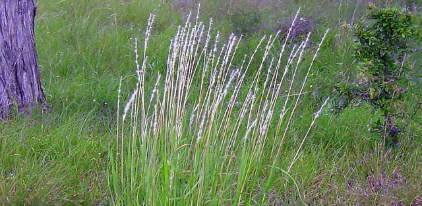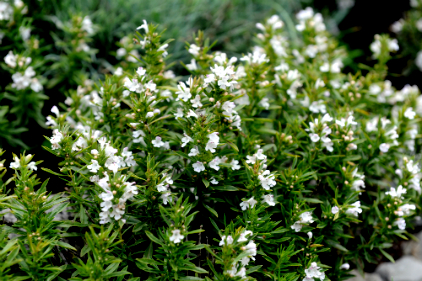
bringing nature, nurseries and gardeners together Oct.11, 2018
Nursery notes: a multitude of events for gardeners happening
this Saturday ; - ) The Wildflower Center's Fall Native Plant Sale
opens at 9 a.m. Follow the link below to see the hundreds of plants
available - along with 5 new native species. Get 3 free plants if
you become a member at the sale: Wildflower Center.
TreeFolks presents Family Day at Laguna Gloria on Saturday
from 11 - 3 p.m. Educational tree walks, beautiful parkland, and
free saplings for all: red mulberry, sweetgum, desert willow, and
beautyberry. 3809 West 35th Street. Laguna Gloria
At 10 a.m. on Saturday a free class at The Natural Gardener: 'Native
Texas Wildflowers, Lawns and Ornamental Grasses,' presented by
George Cates of Native American Seed Company. The nursery also
has some beautiful native asters on sale for $3.99 for 1 gal. (reg.
$7.99) from Friday through Sunday. Support local nurseries! ❦

Silver beardgrass: one of the exciting new plant introductions
at the Wildflower Center's Fall Native Plant sale on Saturday. This
hardy perennial thrives in full sun. ❦
____________________________________________________
Eight indoor crops for winter gardening: lettuces and leafy greens,
citrus, baby ginger, sprouts and microgreens are possible to grow
successfully indoors during the winter months, writes Brian Barth
in a recent issue of Modern Farmer ❦
____________________________________________________
The garden thief: from crack hangout to neighborhood hang-
out, artist gardener David Scalza transformed his street in Hell's
Kitchen in New York's midtown Manhattan with community gar-
dens and art installations. New York Times ❦
____________________________________________________

The Austin Garden is sponsored by the.Hays Free Press

___________________________________________________
Central Texas Gardener: Fall is the time to seed spring wild-
flowers, while late winter to early spring is best for native bunch
grasses. Get tips for the home garden or meadow with Luke Turner
from Turner Seed. On tour, a young family turned overgrazed
land into majestic waves of wildflowers and grasses.Saturday
4 p.m., Sunday 9 a.m. KLRU ❦

Let's Celebrate Winter Savory!
by Mick Vann
Back when Diane "Princess Di" Winslow had her nursery It's About
Thyme up and running, she would sometimes get a little frustrated.
For decades she has lovingly cultivated winter savory plants to pass
For decades she has lovingly cultivated winter savory plants to pass
on to her nursery customers throughout the area, but for some rea-
son, the buying public snubbed the herb.
If those same folks could have tasted a bowl of Di’s Great North-
son, the buying public snubbed the herb.
If those same folks could have tasted a bowl of Di’s Great North-
ern beans (recipe below) flavored with winter savory, they would
be sold. Winter savory, AKA mountain savory, or white thyme
(Satureja montana) is a xeric, perennial herb that is easily culti-
vated in Central Texas.
Growing a foot tall on an evergreen mounding plant, it blooms
Growing a foot tall on an evergreen mounding plant, it blooms
summer to late summer with spikes of white to lilac flowers, with
purple spots on the bottom lip, preferring a haircut after it blooms.
It requires full sun and needs excellent drainage, doing better in
It requires full sun and needs excellent drainage, doing better in
stony soil than rich beds. Winter savory is first cousin to summer
savory and has a stronger flavor than its wimpy brethren (summer
savory really hates growing in Central Texas heat), with a highe
r concentration of thymol and carvacol.
The plant originated in Western and Central Asia, and is consid-
The plant originated in Western and Central Asia, and is consid-
ered native to Southern Europe and the Mediterranean.
The genus Satureja was named by the Roman writer Pliny, and
The genus Satureja was named by the Roman writer Pliny, and
some folks feel it is derived from the word “satyr”, the half-man,
half-goat Dionysiac woodland sprites in Roman mythology who
chased maenids and bacchans.
There is a common etymological origin with the Turkish word sater,
There is a common etymological origin with the Turkish word sater,
the Hebrew zaʾatar, and the Arabic az-za'tar, terms used today in
the Eastern Mediterranean to describe different aromatic herbs or
an herbal spice mix. The Romans used this herb for cooking and
introduced it to Northern Europe during Caesar.
The glossy foliage is intensely aromatic, contributing an herbal,
The glossy foliage is intensely aromatic, contributing an herbal,
sharp, peppery flavor to dishes when added at the last minute,
and mellowing-out the longer it is cooked. Historically it was used
as a substitute for black pepper, and Hispanics use it when epazote
can’t be found.
It is the ideal herb to add to a pot of beans (in German it is called
It is the ideal herb to add to a pot of beans (in German it is called
bohnenkraut, which means “bean’s herb”), and it works well with
meaty stews, or seafood breading. It pairs particularly well with
any type of mushroom, in white sauces and vinaigrettes, and in
potato salads.
Medicinally, it is said to be a remedy for colic and a cure for flatu-
Medicinally, it is said to be a remedy for colic and a cure for flatu-
lence, and has been used to treat gastroenteritis, cystitis, nausea,
diarrhea, bronchial congestion, sore throat and menstrual disorders.
It should not be used in medicinal doses by pregnant women.
Incredibly, a sprig of the plant, rubbed onto bee or wasp stings after
Incredibly, a sprig of the plant, rubbed onto bee or wasp stings after
the stinger is removed, brings instant relief. In the garden, it is the
perfect companion plant for beans (repels bean weevils), and roses
(reduces mildew and aphids).
Princess Di’s Great Northern Beans
Serves 6 to 8
1 pound of apple smoked bacon, ¼ inch dice
1 onion, diced
1 large carrot, diced
2 stalks celery, diced
6 cloves garlic, minced
1 bay leaf
1 Tablespoon + 1 teaspoon chopped winter savory leaves
1 pound Great Northern Beans, soaked overnight, rinsed, drained
10 cups chicken stock
Salt and freshly ground pepper, to taste
_
Heat a large, thick bean pot over medium heat and the bacon, stir-
Princess Di’s Great Northern Beans
Serves 6 to 8
1 pound of apple smoked bacon, ¼ inch dice
1 onion, diced
1 large carrot, diced
2 stalks celery, diced
6 cloves garlic, minced
1 bay leaf
1 Tablespoon + 1 teaspoon chopped winter savory leaves
1 pound Great Northern Beans, soaked overnight, rinsed, drained
10 cups chicken stock
Salt and freshly ground pepper, to taste
_
Heat a large, thick bean pot over medium heat and the bacon, stir-
frying until lightly browned and much of the fat has rendered,
about 5 to 6 minutes.
Add the onion, carrot, and celery and sauté with the bacon until
Add the onion, carrot, and celery and sauté with the bacon until
just beginning to soften, about 4 minutes. Stir in the garlic, bay,
and savory and sauté 30 seconds. Add the beans and chicken stock,
raise the heat to high, bring to a boil, and reduce the heat to low,
simmering the beans and stirring occasionally until the desired
degree of tenderness, about 2 ½ to 3 hours.
Note: To prepare the beans for cooking, pick through for debris
Note: To prepare the beans for cooking, pick through for debris
and stones, and soak in water overnight in the refrigerator. There
should be twice as much water as beans, since they will increase
in volume.
Alternatively, place dried beans in a saucepan, cover with cold
Alternatively, place dried beans in a saucepan, cover with cold
water, and bring to a boil. Turn the heat off, let the beans stand
for one hour, and drain. You may substitute chunks of ham, hog
jowl, or salt pork instead of the bacon. If you use salt pork, soak
10 minutes in hot water and drain before using.
For leftover beans, partially mash and use for bean “tacos” inside
For leftover beans, partially mash and use for bean “tacos” inside
lettuce leaf wrappers, or add some egg and bread crumbs, form
into cakes, dust in rice flour, and sauté until golden brown (excell-
ent topped with cheese and a fried egg). ❦
Mick Vann is a cookbook author, food writer and blogger, restau-
Mick Vann is a cookbook author, food writer and blogger, restau-
rant consultant, recipe developer and horticulturist.

